Questions & Answers – A list of important question, in no particular order
Hypothetical conversation – An imaginary interview of a descentist by an ascentist
Discourse with ascentists – A primer on how I approach and handle interrogations by ascentists
Action – Movement impressed as change in the secondself and thirdself environments; combines with imagination to form manifestation
Altar room – The innermost chamber in my awakening where I still all secondself and thirdself movement to experience my unmoving firstself Presence; my altar room consists of a throne where I may with undisturbed and ponder my creation and my return
Ascent (-ist,-ism) – A linear existential model based on the conviction that I am only a single, temporary observer with limited awareness of a pre-existing universe which preceded my birth and will endure long after my death
Asleepen (-ing) – The experience of transitioning from my second shape into my first shape
- See Awaken (-ing)
Aswaswas – An acronym for “a space within a space within a space”; in triself, the experience of my awakenings as a thirdself being within my secondself which is within my firstself; can be clearly seen when I return to my moment
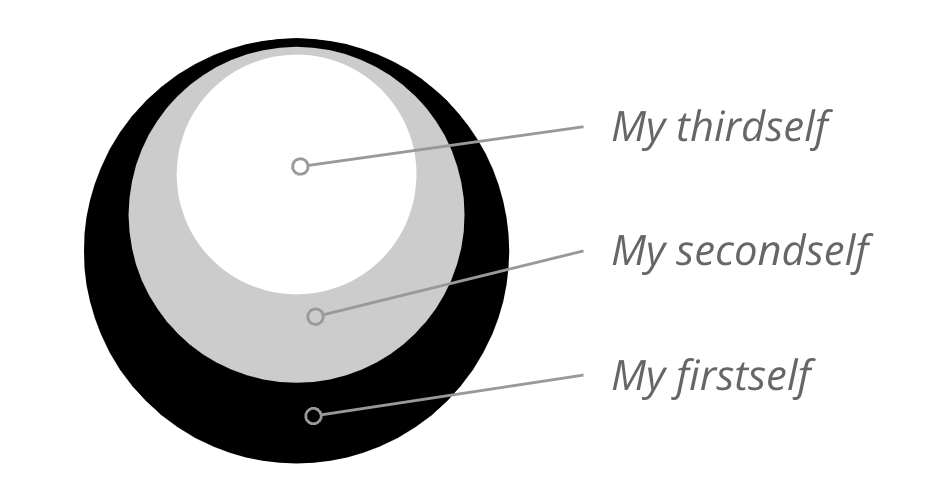
Aspirationalism – A modern ascentist philosophy of constantly striving to “improve oneself” across one or more dimensions, e.g. economically, materially, spiritually, professionally, etc.
Awaken (-ing) – The experience of transitioning from my first shape into my second shape
- See Asleepen (-ing)
Becoming self – (4.8.24) The part of my being that is dynamic and changing; my secondself and thirdself
- Introduced in my incantation “What will I do when I get there?“
Being self – (4.8.24) The part of my being that is constant and unchanging; my firstself
- Introduced in my incantation “What will I do when I get there?“
Being – My first self, experienced in sleep, and temporarily in awakening as a sense of timelessness and freedom from desire
Belief – A notion that supports a desire
- Custodial – A belief that entraps me (see ascentist, reliefist, uniselfist); my foundational custodial desire is the belief that I cannot have everything I want, when I both can and do
- Liberal – A belief that liberates me (see descentist, releasist, triselfist); my foundational liberal desire is that I already do have everything I want
Circularity, my state of – The constant spinning movement that lies at the foundation of my existence, compelled by desire for relief, that underpins my entire illness (aka, life, existence, awakening, etc) and manifests as an inner environment of thoughts, feelings, and aspirations, and an outer environment of people, places, and things
Concentration – The initial act of creation; the mechanism by which I impart substance to all inner and outer forms
Conceptual apathy – The transitional state of withdrawing from suppositional constructs that keep me locked within an ascentist belief system
Conceptual obesity – The state of having over-consumed conceptual forms, and being entrapped in constraining conceptual performances; analogous to perceptual obesity
Conviction – The strength of a belief I hold, evolving from suppositional to experiential
- Suppositional conviction includes beliefs, facts, knowledge, understanding, faith, theory, opinion, and all other forms of knowing that are not derived from my direct experience
- Experiential conviction is the conclusion of all conviction and is the state of being
Conviction framework – The infrastructure required to experience and validate the tenets of a faith
- Demiselfist conviction frameworks such as secular science and religious faith are extraexperiential because they are part of extensive thirdself-oriented structures driven by out
- Triselfist convictions are experiential and do not defer to any outside authority
Demigod – My identity as I begin to remember who I am, what I desire, and reclaim my power by accepting the triselfist model
Demigodhood – The demipotent state of being as I transcend from Person to God
Deminoia – (3.22.25) The state of fractured awareness I refer to as “awakening”, where I believe in the illusion of separation, that I am a person among other people, experience desire, physical and temporal distance, and exist in a narrative with characters and events of my own authorship without realizing it
Demiself – An existential perspective based on the belief that I am a temporary and insubstantial observer of a universe that pre-existed my arrival and will endure after my departure
- See: triself, omniself
- NOTE: Replaced “uniself” in May 2022
Demiself model – The conceptual structure I imagine and impose upon my experience upon awakening; primarily consists of my movement through a linear timeline and three-dimensional space
Demiself conundrum – In demiself, the conflict between my desire to understand my existence while maintaining fallacious beliefs and behaviors
- Examples: Belief in imaginary events like my birth and death; belief in a larger timeline; belief in existential permanence beyond my direct experience; belief that I am one of a larger category of similar beings called “people”
- Extends to behaviors such as speaking in second and third-person, and responding to imaginary and non-existent settings and situations
- See The demiself conundrum
Descent (-ist, -ism) – A circular existential model based on the conviction that nothing exists outside of my projected inner and outer environments
Desire – The force that compels all my inner and outer actions; there are two categories:
- Essential desire – My core foundational desire for permanent peace; experienced most strongly in the second place upon awakening and prior to asleepening
- Inessential desire – My essential desire misdirected toward transitory relief and away from permanent peace
Desire progression – The sequence of desires that accumulate and dissipate with every awakening
- See Hierarchy of desire
- See Hierarchy of value-desire
- See My essential desire
- See My inessential desires
Desubstantiation – (2.10.24) My process of demanifesting and dismantling the vast subsurface I imagine to exist below the surface of my awakening
Distortion, the – A misleading layer of confusion and illusion I call my awakening experience (aka, “life”) that obscures my self-realization and entangles me in
Emanant – (n) In the triselfist model, referring to any form or construct in my awakening
Emanation – In the triselfist model, my awakening into my second and third selves
Essential clay – The stuff of my existence, forming into the first shape and the second shape
Essential – The fixed, formless point at the center of my being in the second place; also known as the first place, my first self
Essential detachment – The experiential sensation of the second place as occurring within the first place, rather than the other way around
- See Essential detachment
Existential alignment – The state in which my essential identity and my actions in my awakening are aligned
Existential characterization – The particular conceptual constructs I have used at various points in my contemplation to characterize my existence; for example:
- In the Christian characterization, I am god when I sleep and I am satan when I wake; the Garden of Eden or Heaven is sleep, and Hell is my waking life; (Romans 1:25) They exchanged the truth about God for a lie, and worshiped and served created things rather than the Creator; the Tower of Babel is not about languages between different peoples, but the complexity and diversity of my own ideas and beliefs as the source of my confusion (See Descentism and christianity)
- In the Circular characterization, life is a state of disease and illness attributable to literal “spinning”, which manifest as the disorientation and distortion I experience both conceptually and perceptually
Existential model – The set of ideas, beliefs, and convictions I maintain to explain and understand my existence; there are two model types: ascentist, and descentist
- Mono-conceptual – The conceptualization of a single substance or nature of which all is composed, simplifying the characterization of my existence
- Poly-conceptual – The conception of an inner environment comprised of many inner forms and performances
- Mono-perceptual – The perceptualization of a single, monolithic outer form or shape
- Poly-perceptual – The perception of an outer environment comprised of many different forms, shapes, and sensations
- Uniceptual – The fusion of the inner and outer environments into a single whole; occurs in the first place, and in the second place upon descent
Existential dichotomy – The fundamental paradox of my second place existence which reveals the truth of my nature
Existential primitives – Fundamental aspects of my direct experience that indicate a very different nature when reconsidered
Existential tracing – The process of tracing a concept or percept from source to experience in order to understand its nature
Experience-conviction gap – The difference between what I believe and what I directly experience, filled in by imagination, supposition, conjecture, apathy, faith, and ignorance; in ascent, the gap increases, but in descent the gap decreases
Experiential field – My range of conceptual and perceptual experience at any given moment, or within the context of my triself
- Conceptual field – My inner environment
- Perceptual field – My outer environment
Experiential fluidity, elasticity – The conceptual and perceptual elasticity of the various forms within my existence; how inner and outer movement create apparent change within all forms and shapes
- Conceptual elasticity – If I mentally or emotionally fixate on a concept, I will manifest increasing detail
- Perceptual elasticity – If I fixate on a percept and move toward it, the perceptual detail will become more granular
Experiential layers – The three distinct components of my awakenings
- Firstself – My true Being
- Secondself – My familiar but delusional identity as an individual person within a larger world full of similar beings
- Thirdself – The outer space I experience as a larger world in which I temporarily awaken into and move about
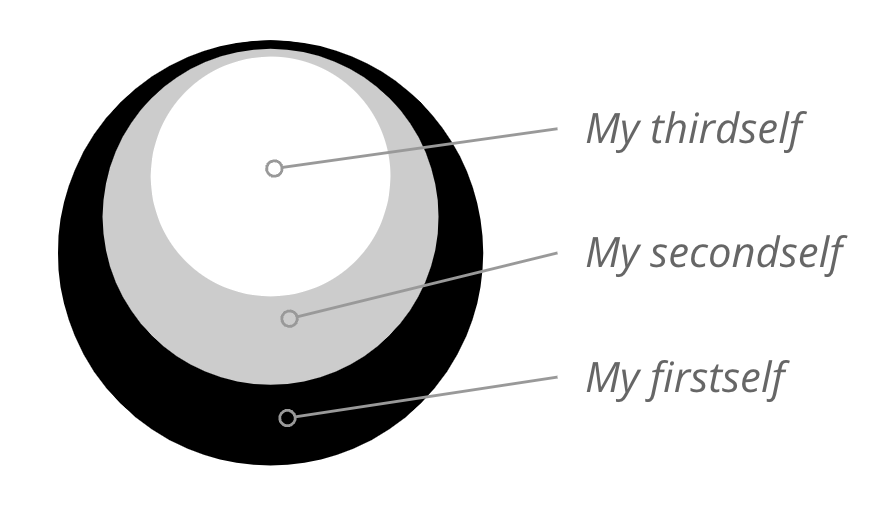
- My firstself is the outermost, unchanging envelope of my Being; my secondself is my familiar identity of my awakenings, and serves as a conduit between my first- and thirdselves; my thirdself is the space I commonly conceive as a larger outside world in which I move about
Experiential mechanics – The fundamental working of my existence from the triself perspective; as opposed to extraexperiential mechanics which describe my existence from the demiself perspective; consists of three interlocking factors: desire, conviction, and power
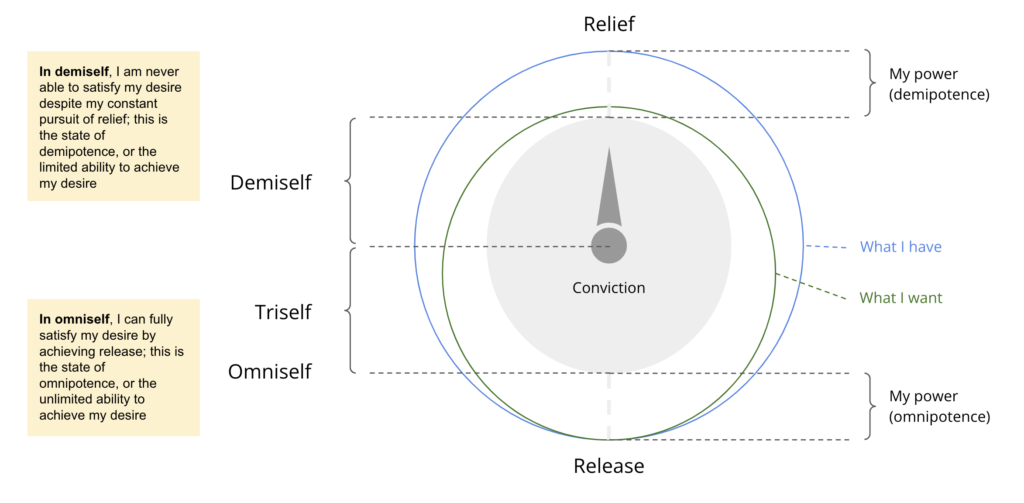
Extraexperiential – The idea that there is a larger existence beyond my own direct experience; can be further broken down:
- Extraconceptual – The idea of conceptual forms existing beyond my own conceptual (secondself)
- Extraperceptual – The idea of perceptual forms existing beyond my own perception (thirdself)
False Desire – (5.21.23) Objects of desire that will only deliver temporary relief, and lead to additional false desires
- opposed to True Desire
False Journey – (5.21.23) Awakenings spent in pursuit of false desires, and leads to additional desire, pain, and awakenings
- opposed to True Journey
Fascination, the – (12.28.23) Describes my value of, and consequent pursuit of and engagement and entanglement with the contents of my awakening, including specific experiences, sensations, relationships, possessions, achievements, and more; alludes to the fascination a baby exhibits when looking at simple changing shapes and colors, extending it to the same sense of engagement and obsession I presently experience as an adult; the fascination compels me to value and desire certain experiences, sensations, distractions, relationships, achievements, possessions, and more
Feature – (6/16/23) A component of my awakening, occurring in either secondself or thirdself, but not firstself
- In secondself, the features are anything that I experience “within” and “before” thirdself begins: thoughts, desires, memories, feelings, unseen physical sensations
- In thirdself, the features are anything that I experience “external to” and “after” secondself ends: objects, people, creatures, places, events
Firstself – Repossessive referencing of my unmoving and all-encompassing being in the triself perspective
First Belief, My – My first decision upon awakening to believe my second and third selves
First Power, My – My unlimited power to create, exercised by my decision to believe and move; concepts and percepts do not exist independent of my first power
First Question, My – The question, “where am I?”
Flesh of My Moment – (1/14/24) A way of describing the substance of my awakening experience as my own flesh rendered and shaped into the people, places, objects, phenomena, and sensations of my awakening
Focal awareness – In the second place, the direction of my attention into one of three places: the outer projection, inner projection, or essential from where both originate
- See Focal awareness
- See Focal awareness around people
- See Harmonizing my inner and outer projections
Focalization – (1/1/23) The condition of my secondself, where my inability to be who I am in my entirety causes me to focus and distort my omniself into multiple layers
Form – Any inner concept or outer percept that can be defined, sensed, or experienced in any way
- See Understanding forms
God – My firstself, experienced as sleep, and as the desire for peace in my awakening
Godhood – The omnipotent state of being God
Halo (-ing) – A physical sensation around the crown of the head experienced as buzzing; experienced during revelation, prayer, contemplation, and moments of focal awareness
- (4/13/24) Redefined as a “resonant moment” or “resonance” that can be both intellectual as a realization, but also sensational as the experience of what I have called “haloing” around the crown of my head
Hierarchy of desire – A model of my second-place existence in terms of my desires
Horizon – The outer extent of my second- and thirdselves; in my secondself, my horizons extend as ideas, sensations, feelings, imagination, and aspirations; in my thirdself, my horizons extend visually to the sky and the furthest perceptual reaches
- Experiential horizon – The point past which I no longer directly perceive; this is a constantly fluctuating outer limit
- Imaginary horizon – The point past which I no longer imagine or conceive
I am existence – The Fundamental Truth, Original Incantation, Essential Incantation from which all others descend
Identity – The idea of who, what, and where I am; can range from my essential identity to my inessential identity
Imagination – Movement of the inner environment; the faculty or action of forming new ideas, or images or concepts of external forms not present to the outer senses; combined with action to form manifestation
Imagined us, the – (12.6.22) The imaginary construct that I am one member of a collective group of beings called “people”; the starting point for all my demipotent convictions
Imaginism – The delusional state of conceptualization detached from, or very tenuously and indirectly attached to my present moment, including:
- Time-based knowledge
- Fantasy
- Ascentist desire
- Academic knowledge
- Social knowledge of an imagined individual or group of people
- Rhetorical knowledge, discussions, and flourishes
- Conceptualizations of a past, from my own memories to theories and suppositions
- Conceptualizations of my future experiences
- Conceptual or hypothetical magnification
Impulse – (7.7.24) The root of my awakening triself experience as a compulsion to act, move, and thus nourish my mindself, bodyself, and worldself; Often manifests as “desires” that prevent me from being “still” and “content”; Can be exposed by observing my compulsion to think or move when I close my eyes
Incantation – An expression of any sort from my secondself that eases my thirdself bond, allowing greater firstself-awareness
Inessential – Comprises the entirety of the second place experience, including all forms and performances; also known as the second place, my second self
“Language of the lost” – A multitude of speaking and thinking patterns, practices, and conventions that reinforce the traditional existential model (i.e., ascentist) based on supposition rather than direct experience, aka imaginism; including:
- Speaking or thinking about topics and subjects of which I cannot or do not know anything
- Speaking or thinking about people I do not know or am not presently engaged with
- Speaking or thinking about topics or events outside of my direct experience
- Use of grammatical constructions that imply equivalence between Me and others
- Use of language or thinking patterns that place a “center” external to the known Center I directly experience
- Opining on topics or subjects that are abstract
- Engaging in unfettered imagination or examination of subjects or topics of little or no value to my descent
Last Answer, My – The answer to my first question, “where am I?”
Life – My collective experience of awakenings
- the awakening
- the distortion
- the sequence of awakenings
- the eternal moment of desire
- the manifestation
- the constellation
Manifestation – The constellation of all concepts and percepts that form my second shape; the intentional or unintentional coordination of inner and outer movements (i.e., imagination and action, respectively) to create change, forms, and performances
- Demanifestation – The intentional or unintentional release of inner and outer forms and performances; descent is the intentional, willful process of demanifestation
Manifestational capacity – My limited ability to project my conceptual and perceptual environments; I can only perceive and conceive a certain amount at any given moment
- See Perceptual and conceptual constraint
Manifestational constraint – The intentional limitation of my inner or outer projections in order to concentrate my focus nearer to my essential
- See Perceptual and conceptual constraint
- Also, inessential constraint
Meditation (selfist) – Meditation performed with a specific intent and understanding grounded in triself
Midplace, the – (12.7.22) The place just between the first and second places; my state just after awakening into secondself or just before asleepening from secondself
Model shift – The experience of shifting downward from demiself to triself
Momentary sovereignty – (3.30.24) The re-establishment of my complete authority over the shape, size, and contents of my moment; will coincide with my manifestation of “miracles” and performances which are inexplicable in the Personal model
Movement – I experience by inner and outer movement; imagination is the inner equivalent of outer physical movement
My moment – My experience as an unending now of emanation; used from my firstself, rather than my thirdself perspective; usage of it is my repossession of time
My three selves – The three forms of “me” that exist; synonymous with “the two places”
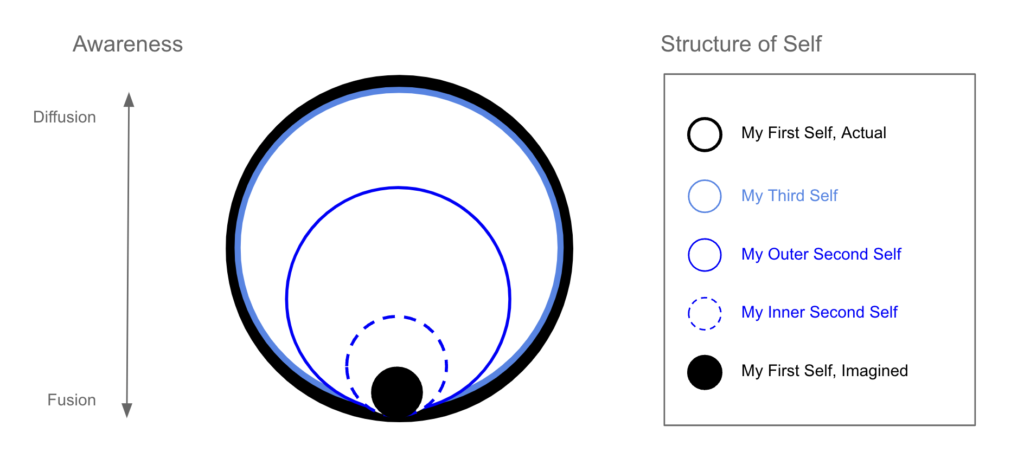
- My first self – My actual identity; in awakening, I sense it at the core of my being, “before” my second self
- My second self – The person I imagine I am when I awaken into the second place, extending outward and ending at my physical body (aka, my familiar self)
- My third self – The perceived outer environment that begins where my second self body ends and extends outward to the very outer reaches of my perception; this includes all perceivable objects, people, and imagined places and things
Now and Back Exercise (NBE) – A simple exercise that exposes the nature of my existence; repetition and interpretation solidifies and reinforces my conviction
- See How desire works
Omninoia – (3.22.25) – The state of undivided awareness free of any spatial, temporal, or essential otherness; free of desire, separation, narrative, characters, or the illusion that I am part of something else rather than the whole of everything
Orientation – The direction of my effort toward illness or healing (i.e., ascent or descent, respectively), based on my awareness of my original desire and understanding of how to satisfy it
Original desire – My inescapable, first and last desire for permanent and lasting peace; I suppress my original desire when I awaken, but succumb to it when I asleepen
- Also, essential desire
Origin – Where my existence originates and terminates
Origination – My decision about the origin of existence; encompasses the first question and the last answer
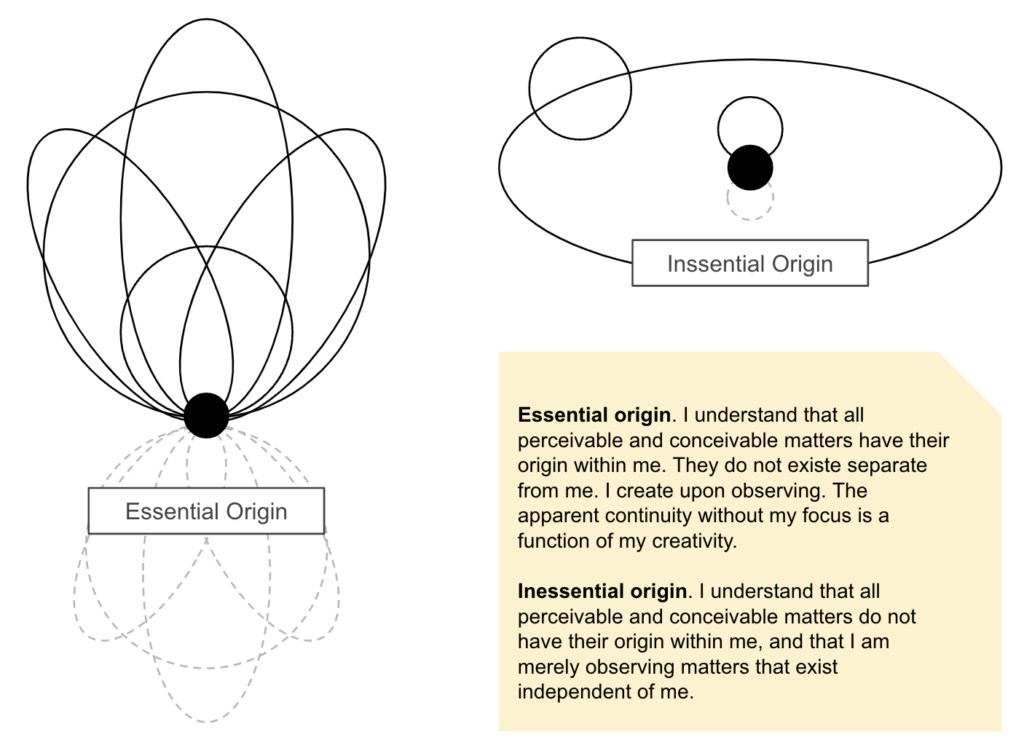
Otherless / Otherlessness – (7.8.24) The conviction or practical experience of there being no other beings than me, no other times than now, and no other spaces than here; I experience this in my awakening conceptually and experientially during “prejection”
- Beinglessness – The premoment state of my existence as the only being
- Timelessness – The premoment state of there being no other time than my present moment
- Spacelessness – The premoment state of there being no other space than the one I presently occupy
Otherness – (7.8.24) The conviction or practical experience of there being other beings than me, other times than now, and other spaces than here; I experience this in my awakening during “projection”
Peace – The objective of my essential desire (see “Desire”); permanent and lasting; opposite of relief, which is transitory and misleading
People – (11.21.22) The fleshy characters that populate my secondself and thirdself
Personal Model – (9.1.23) The collection of delusions that reinforce my belief that I am a person temporarily experiencing “life” on a planet that pre-existed my birth and will endure after my death
- In contrast to the Selfist Model which is based on my direct and actual experience
Personal science – The systematic study of my awakening from the perspective of my direct rather than imagined experiences
Person – My secondself and thirdself, experienced as my awakening, and as a constant desire for something
Personhood – The demipotent state of being a person
Prejection – (3/3/24) The awakening state of withdrawal from my thirdself and/or secondself projections, achieving a near euphoric moment of detachment in which I can accurately understand my true nature, and experience the triviality of my imagined personhood; the conscious withdrawal from or reversal of the process of projection; a deliberate mental or emotional detachment from the external manifestations of my thoughts, desires, and perceptions
- See projection
Principle demonstration – (3.31.24) Closing and then opening my eyes as a demonstration of my true nature; the simplest of all actions I can perform, serves as a live experiment of the true nature of my Being
Principle of descent, first – I must base my existential model on my direct experience rather than imaginary or suppositional knowledge; my objective as a descentist is to close the differential gap between my expression and my experience of my existence
Prismatic moment – The experience of my moment fracturing into ever-smaller, more distant secondself and thirdself sub-forms of awareness; occurs when I focus or concentrate
Productivity – The state of creativity stemming from inner and outer movement
Projection – (3/3/24) The awakening state of creating my secondself and thirdself chambers; also known as manifestation
- See prejection
Projection alignment – (3/3/24) The degree to which my secondself and thirdself projections are aligned; an example of non-alignment is my secondself conviction that other beings, times, and spaces simultaneously exist even though I do not directly experience them in thirdself; alignment occurs when I accept in secondself what is true in thirdself in my moment
- See Projection alignment
Projection depth – (2/24/24) The degree of “distance” I imagine time-wise from my present moment and a belief I interpret as a “memory”; serves as an important element in a reconstructed, selfist model of time as I conceive and experience it, and requires that I redefine memories as a form of belief, rather than a separate impression of an actual event that occurred
- Example: The only difference between my “earliest memory” of my mother and my memory of what happened yesterday is the depth at which I project these two impressions, and how I conceive and experience that depth. I experience the sensation of an “older memory” now, in my moment, and layer that meaning upon the projection, misinterpreting it as a quality of an independent imaginary event itself rather than as an attribute of my projection.
- See Practical presentism and projection depth
Reawareness cycle – The cyclical movement of continuously forgetting who I am (triself-ignorance) and rediscovering it (triself-awareness)
- See My triself pronoun structure
Recovery space – The point at which I begin to craft my second and third selves into a shape conducive to my healing and descent; my perspective changes from passive observer to active creator of my awakenings
Release – The objective of my essential desire; my core desire at all moments for permanent and lasting peace (opposite of relief)
Relief – The objective of all my inessential desires (opposite of release; see “Desire”); transitory and temporary
Relief cycle – (10.11.23) The repetitive loop of awareness of my suffering → desire → temporary satisfaction → renewed yearning; the engine of narrative continuation
Reorientation – The process that occurs when the true nature of my existence becomes known to me through revelation, prompting a change in my focus and movement away from my second shape and toward my first shape
- See Reorientation
- See Formal demanifestation
Repossession – The logical culmination of acknowledging my firstself as the origin of my awakening, my secondself as the conduit, and my thirdself as the product; and then assigning correct ownership and expressing it correctly
- repossession of self – redefining the aspects of my existence in terms of the three layers of myself: my firstself, my secondself, and my thirdself
- repossession of authority – reclaiming my ability to understand, know, and explain my existence from my thirdself
- repossession of time – breaking the imagined linear construct of time by thinking and expressing in terms of my moment
Secondself – Repossessive referencing of my inner space of thoughts, feelings, aspirations, beliefs, and feelings in the triself perspective
Selfist Model – The existential framework that divides my perspective between the uniselfist and triselfist models; a refinement and replacement of the Descentist Framework
Self-centric – A conceptual model of existence that is centered around my direct, authentic experience rather than an imaginary construct
Shared reality – The construct I imagine of a temporary existence within a larger universal environment experienced by me and many others through time and space
Shepherd’s language, the – (11.20.22) The language of the thirdself shepherd class of people, which is designed to be circular and inconclusive to undermine my independent resolve
Shepherd’s poison, the – (11.20.22) A question by the imagined authorities (i.e., the “shepherd”) that appears to undermine my omniself but is in fact subordinate to it, for example:
- Being able to articulate “how” I manifest the entire world in its infinite detail and complexity does not preclude the fact that it exists because I awakened
Social virtues – Part of the shared reality; a set of imaginary qualities I admire, respect, and emulate; calibrated in terms of an imagined shared reality; they obstruct and interfere with descent
Strange room, the – The place I experience upon awakening and before asleepening
The Actor – My secondself persona and thirdself presence who performs personhood upon awakening
The two places – The first and second places, which together form the entirety of my existence
- See The first place
- See The second place
The two shapes – An understanding of my two states as “shapes”, which together form the entirety of my existence
The second place – My familiar state which I experience as a physical body navigating through an objective outer environment, extended by a subjective inner environment; also known as my second self
The something – In the triselfist model, the constant experience of a desire for something in my awakening
The first place – My state when I am sleeping; also known as my first self
The lost – Referring to the group of character forms who are unaware of my/our true nature; i.e., normal people who believe the standard ascentist narrative of their existence
Thirdself – Repossessive referencing of the outer world of people, places, objects, motion, and change in the triself perspective
Thirdself phantom – The belief that the external world continues to exist even when I close my eyes, and the low-resolution lingering imaginary visualizations of the space around me after closing my eyes; compare to object permanence
Triself (-ist, ism) – My collective existential structure in my awakened state, divided into three selves: my first self, my second self, and my third self
- Triself-awareness – In my awakening, moments of absolute clarity about the nature of my existence, derived from an intense concentration of my awareness
- Triself-ignorance – In my awakening, longer periods in which I am unaware or unconcerned about the nature of my existence, derived from a broad diffusion of my awareness
Triself (revision) – (6.30.24) A redefinition of the earlier concept of triself comprising firstself, secondself, and thirdself as comprising instead mindself, bodyself, and worldself; Allows easier alignment with my actual experience; Introduction of coreself as the source of triself
- Coreself – Formerly “firstself”; A timeless, spaceless, beingless, otherless state that precedes the triself
- Mindself – Formerly part of “secondself”; A space filled with thought, desire, and time-shaped projections
- Bodyself – Formerly part of “secondself”; A space filled with feeling and sensation-shaped projections
- Worldself – Formerly “thirdself”; A space filled with light, color, and form-shaped projections
True Desire (5.21.23) – Objects of desire that will deliver permanent and lasting release, ending my awakenings
- opposed to False Desire
True Journey (5.21.23) – Awakenings spent in pursuit of my true desire for lasting peace
- opposed to False Journey
Uniself (-ist, ism) – My traditional belief I am one of many people who have existed in the past, do exist in the present, and will exist in the future; that existence is larger than my own direct experience of it
Unwaken / Unwakening – (6.15.24) The process of withdrawing from my awakening; Counter-awakening
Whyism – The circular, unending pursuit of answers
Ascent vs Descent – Ascent is the pursuit of relief, while descent is the pursuit of peace
Descentism vs Christianity – These are the same story told with different expressions
Essential / Inessential vs Descentist / Ascentist – The essential and inessential are places, whereas descentist and ascentist are orientations toward those places.
- An ascentist is moving away from the essential and toward the inessential.
- A descentist is moving toward the essential and away from the inessential.
Demanifestation vs Disengagement – Disengagement implies that the existence of the form or performance from which I am withdrawing remains after my disengagement; to the contrary, demanifestation explicitly declares that the form or performance deflates with my demanifestation
Memories have depth – Memories are secondself conceptual constructs occurring only in my moment; they do not represent events that happened, but rather my reflection on my present and only existence
Reality vs Substantiality – The concept of reality demands a binary decision about what is and is not existent; in descentism, I prefer “substantial” over “real” because it implies no such determination, freeing me to recognize subtleties in transitioning from ascentist to descentist
Relief vs Release – All my inner and outer actions can have one of two objectives: relief, or release. Inessential desire for relief is the temporary alleviation of my suffering gained by certain actions, events, and achievements within the second place. Essential desire for release is the permanent achievement of peace that comes with my return to the first place. When I expand and move outward away from my first self, I am seeking relief. When I contract inward, toward my first self, I am seeking release.
Suppositional vs Experiential Knowledge – Suppositional knowledge is that which is imagined but not directly experienced; experiential knowledge is that which is directly experienced
Viewport – (11.21.22) A region of my firstself through which I experience sensation
- Secondself Viewport – The irregular-shaped region of my firstself in which I experience mental, emotional, aspirational, non-visual physical sensations
- Thirdself Viewport – The oval-shaped region of my firstself through which I experience the visual and physical world
Retired Concepts – These are words and concepts that I no longer use in my active vocabulary, but which are still in use in previous posts and writings on the topic.
…
